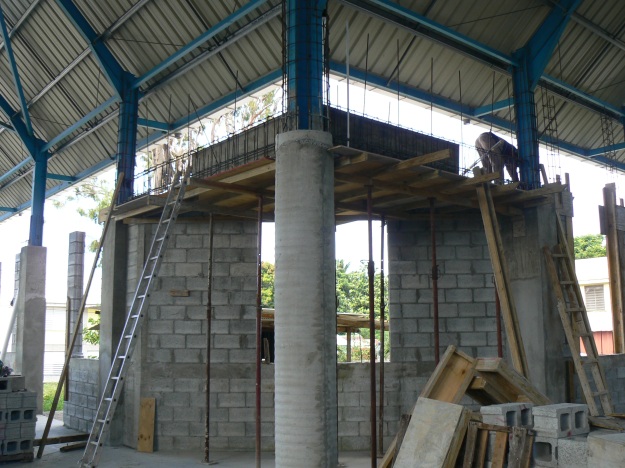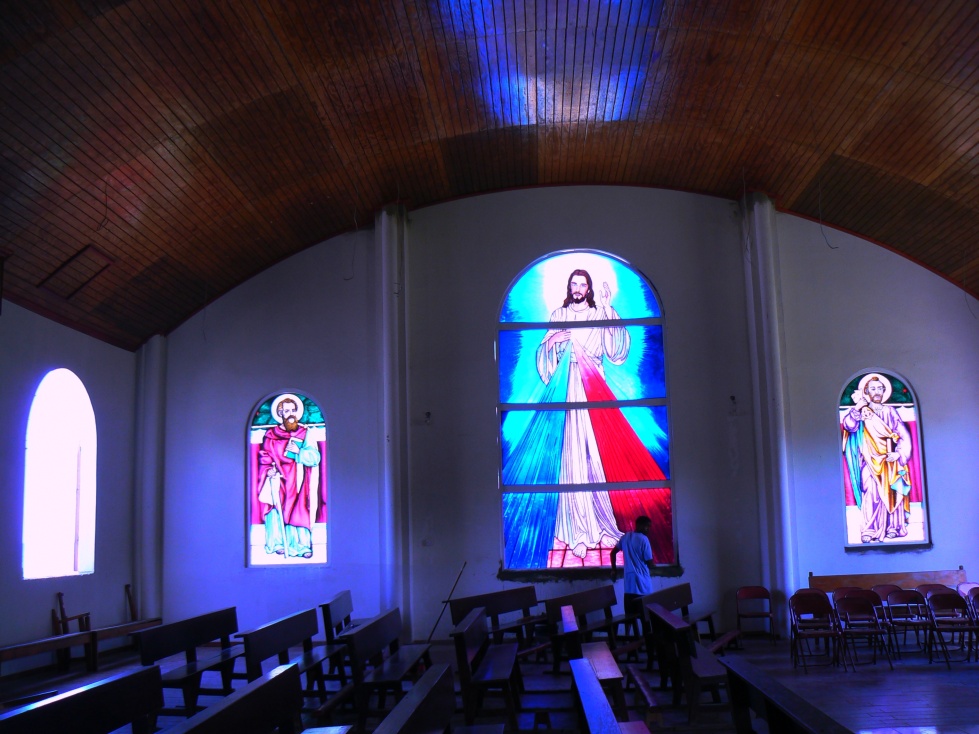The construction works, halted due to lack of funds, have restarted !!!
Monthly Archives: October 2014
Sts Peter and Paul chapel in Calibishie is taking shape
UPDATE on the renovation of the Roseau Cathedral
Fr. George Paddington, the first black priest in Dominica ?
by Bernard Lauwyck
The St. Peter’s church in Colihaut in 2014: the location of Fr. Paddington remains
Recently I got an e mail from New Orleans asking me if I could find anything about a priest named George Paddington in the records of our Diocese. At first I did not find anything at all, but as my curiosity was kindled I dug deeper and discovered some exciting information.
According to the records Rev. Fr. George “Parrington became parish priest of St. Peter’s [Parish in Dominica] ; but according to a vague souvenir of the population he mostly resided at Dublanc, a pretty large hamlet some two or three miles to the north of the village proper. His stay, however, was of short duration. Two years after his arrival in Dominica ,he became incapacitated by illness. He died before he was able to receive medical assistance, and was buried in the shadow of the little parish church built by his predecessor. His remains are under the High Altar of the present St. Peter church in Colihaut, built in later years.”
This information was published in November 1924 in the Ecclesiastical Bulletin of Roseau.
Upon submitting this information to my US correspondent, Mr. Jari C. Honora, he divulged that Fr. George Paddington was a black priest:
“My interest in Father George John Paddington stems from the fact that he was the first black priest ordained by a North American bishop. He was born about 1808 in Cork City, Ireland. He must have been quite an oddity – a black man with the accent of Ireland! He was ordained at Port-au-Prince on 21 May 1836 by Bishop John England of the Diocese of Charleston, South Carolina.”
Well, I can tell you that my heart beat quickened and blood pressure went up as I was in the process of discovering unknown religious history of Dominica:
Fr. George was undoubtedly the first black priest who served in Dominica.
But then my doubts were raised. Was this really the same person or just a name sake? Was there a link between this priest from Port-Au Prince and our priest in Colihaut ? I needed independent attestation .
This I got from a letter written by Bishop Richard Patrick Smith (1802-1852) of Port of Spain on the island of Trinidad, which I found on http://www.library.unisa.edu.au/condon/CatholicLetters/18491104.htm
I quote from his letter, dated 4 November 1849, written to Cardinal Fransoni, the Prefect of the Sacred Congregation of Propaganda Fide : “ Abbé Paddington has arrived here from Santo Domingo, about two months ago. I advised him to write to your Eminence to inform you of everything relating to the Mission of Haiti, and to await orders from your Eminence. I gave him a post on Dominica while he waits. I have just learned that he is doing much good, and that he is respected and esteemed.
Alas! Since the month of January last, we have lost five excellent Missionaries, they unfortunately having been placed in very unhealthy locations, and too far from the care of doctors. But what can I do? In those very locations there are many large Catholic Congregations.”
This corresponds with some additional information I got from Mr. Honora :
“Fr Paddington left Haiti about July/August 1849, arriving in Port-of-Spain, Trinidad, where the Vicariate Apostolic was located. The Apostolic Vicar, Bishop Richard P. Smith, assigned him to Dominica. ”
Bishop Smith was Vicar Apostolic of Port-of Spain from 1844 till he became Archbishop of Trinidad in 1850. Most importantly he was an Irishman as was Fr. Paddington. Remember that the first Bishop of Roseau (1850 -1855), Michael Monaghan, a colleague of Smith in Trinidad, was also Irish.
I still wanted confirmation that Fr. Paddington was indeed a black priest and this I found confirmed in the diaries of his fellow traveller, yes another Irishman, on the boat from Trinidad to Dominica. Rev. Dr. John T Hynes (1799-1868) was a catholic bishop who travelled extensively, from his birth in Cork ,Ireland, through ordination in Kentucky, and worked in Cincinnati, Grenada, Demarara (= Guyana), etc.
The DIARY OF JOHN THOMAS HYNES, 1843-1868 can be found on www.library.unisa.edu.au/condon/Hynes/index.htm.
I quote from his entry of August 1849: “In the evening of the 20th.I arrived at Trinidad. Called immediately on Dr Smith, who accompanied me to see the Convent and College.
- August 20th. 7 p.m. Left Trinidad for Grenada – met on board Father Paddington, bound for Dominica.
- August 28. 6 a.m. off Dominica, where Fr. Paddington landed. Received from Fr. P. 20 gold pieces to be given to his sister in Cork.
A few days later as he travelled away from Dominica, Bishop Hynes had a dream :
“ 1849. Sept‘r. 1st. The wind still continues fair but not so strong. Last night I had a strange dream – I thought that one of the Nuns was dead and that I was preparing to perform the funeral ceremonies. …. A carriage drove up to the house in which was Fr. Paddington and another black priest…”
So far the dream of Bishop John Thomas Hynes in which he confirms that Paddington was a black priest.
Having the link between Haiti and Dominica and the identity of Fr. George Paddington, parish priest of Colihaut for two years ( 1849-1851) confirmed , I cannot wait to present you with more information on the first black priest in Dominica.









